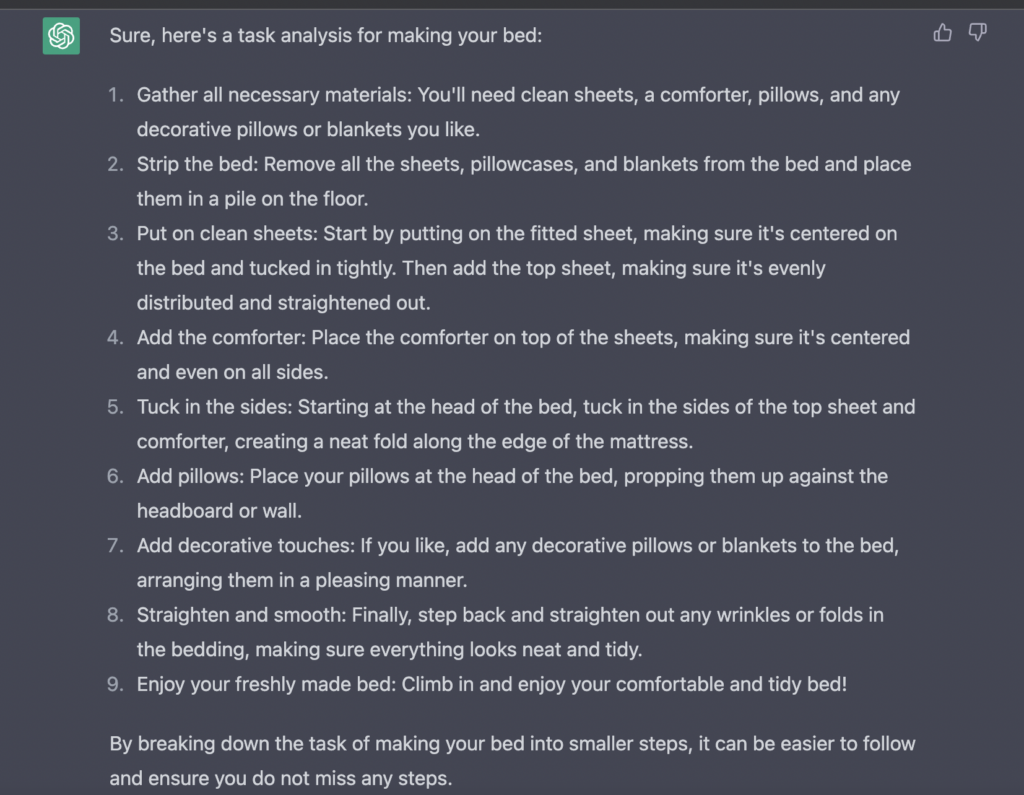Estimated reading time: 10 minutes
Are you having one of those days where “I don’t feel like doing the work” today? This is a normal experience but for people with conditions like Attention deficit hyperactivity disorder, commonly known as ADHD (or ADD – without the hyperactivity), this statement is not just a “feeling.”
For someone that is neurodivergent, “I don’t feel like working” or even “I don’t feel like going to work” can feel bigger than climbing Mt. Everest or deciding you’re running for president. In fact, the feeling can be so big that you may never start at all.
The rest of this article will speak to tips and tricks for ADHD. If you’re not struggling with ADHD, these tips and tricks are based in recommendations known to promote dopamine.
Dopamine is a motivation hormone — that when you don’t have ADHD, you typically have normal amounts of. Doing things that work to boost dopamine in someone with ADHD also boosts dopamine in someone without it. We’ve seen first hand how building for accessibility can really benefit everyone.
Table of contents
A Little About ADHD Symptoms
Attention deficit hyperactivity disorder, commonly known as ADHD, is a neurodevelopmental disorder that affects millions of people worldwide. It is characterized by difficulty paying attention, hyperactivity, and impulsivity. These things can make it challenging to complete tasks and achieve goals. Like climbing Mt. Everest.
People with ADHD may find it particularly difficult to focus on tasks that they don’t find interesting, leading to procrastination and avoidance of work. Even if you absolutely adore your job, there will be tasks that just aren’t interesting. Various external factors, such as rewards and pressure, can significantly affect motivation for individuals with ADHD.
When it comes to work, one area that I struggle in can be in meetings that are “too slow.” Unlike a video on YouTube, I can’t speed up the conversation, and I end up unengaged — this sometimes results in getting distracted, trying to get work done at the same time in order to “stay alive” (or even just in motion — because if I stop, getting started again…)
Fortunately, there are strategies that can help individuals with ADHD overcome feeling like they don’t want to work and still stay productive even when it’s as big as Mt. Everest.
Often times, getting started is the hardest part. Once we check out that initial little box, it’s often a snowball effect of dopamine and once we’re in motion, it can be easier to stay in motion. Understanding these neurological underpinnings can help in addressing motivation deficits. Here are some suggestions on how to get that motion rolling.
Tips & Tricks for when you really don’t want to do work today
Often times, getting started is the hardest part. Once we check out that initial little box, it’s often a snowball effect of dopamine and once we’re in motion, it can be easier to stay in motion. Here are some suggestions on how to get that motion rolling.
Let’s try Task Analysis
I’m biased to this one because I’m a project manager but let’s try to be a bit more realistic here than all the articles that simply say, “break tasks into smaller, more manageable pieces” and lets use some actual examples.
Whether at home and the work is doing the dishes in the very full sink or needing to start that really boring powerpoint presentation that someone in leadership is asking for, large and small “projects” can be easier to manage when broken down into smaller pieces. Let’s take it a step farther, through.
Let’s learn how to break them down through Task Analysis, which can help in breaking down and completing tasks more effectively.
Try not to google for Task Analysis before you’re ready
Before we go any farther, consider avoiding googling “Task Analysis” until you’re ready — particularly if you are here because you are actively trying to avoid working right now.
If you’re like me, you’ll could end up spiraling down the rabbit hole and suddenly end up in a Coursera class on UX or in human factors engineering. In fact, getting supporting research for this article even almost lost me for a little bit (we’re UX nerds here — it’s how we build a system with our own ADHD in mind).
Task analysis is the act of observing how an activity is done and gathering relevant information about the how of it being done.
In the book User and Task Analysis for Interface Design, they note that performing a task analysis helps you understand:
- What are the goals here; what is trying to be achieved?
- What actually needs to be done to achieve those goals
- What from the physical environment is influencing the event?
- Self awareness: How does your previous knowledge and experience influence
- How to think about the work
- The workflow to follow to perform tasks
If you’re not sure where to start with task analysis, here are some suggestions:
- Try Google search for a visual task analysis of “xyz”
- Try youtube and search for a how to video.
- ChatGPT?
- Make your own. If you’re visual, use Canva.
I tried ChatGPT4 to “complete a task analysis for making my bed.” If you’re good at ignoring excess steps, this worked well. I found the suggestions to be too much and would recommend giving more detailed instructions. Here’s ChatGPT’s view on it:

Why do Task Analysis?
When faced with a large project, the feeling of “I don’t even know where to start” or the size of the project can be overwhelming for when you have ADHD. This can often lead to procrastination and avoidance. By breaking the work into smaller pieces, it can become more manageable and less intimidating to say, “I’m only going to do Step 1”.
Lastly, when breaking things down into smaller lists, don’t hesitate to set specific goals for each piece of the project and reward yourself when you complete each goal. Working towards a goal is shown to help promote dopamine and this can help you get motivated to start.
Create a routine but not necessarily a scheduled routine
When our brains tend to go so quickly, particularly some of us with hyperactive type, it can be helpful to create a structured routine. This forces your body to go into more of an autopilot; similar to the experiences you have when you’re driving and thinking. Harder tasks can become something you just “do.”
Now, ADHD also impacts executive functioning — this means it gets harder to do things like create a structured routine so it isn’t this simple. Repetitive tasks can become monotonous and demotivating for individuals with ADHD. Incorporating novelty and rewards into these routines can enhance engagement and motivation.
One way I’ve found helpful to manage is, particularly when it’s a task associated with work, I create a “routine area” and a “routine” that signals to my body that its time to work even when I’m mentally not prepared.
In this case, I set up an effective work space and that’s the only space I work. I don’t use it for play time, goofing around, or distractions. When I’m there, I’m go. This can also be done with a music routine, coffee or tea routine, but something that you do every time that signals to your body that you’re about to work.
Time Boxing or Body Doubling: Effective Motivation Strategies
Another adventure-provoker of ADHD is procrastination. This makes sense biologically even if it feels like stress. The reason being that crash rush of a deadline causes a release of dopamine (and dopamine irregularity is a challenge for us). Procrastination gets particularly worse when tasks are unpleasant or uninteresting.
Extrinsic motivation, such as external rewards, can be necessary to motivate behavior in individuals with ADHD. Once you’ve decided to work through procrastination, both time boxing and body doubling have been effective in helping others overcome the challenge.
Time boxing
Set a specific amount of time for working on a task, and then take a break when the timer goes off. This can help you stay focused and motivated, as well as provide a sense of accomplishment when you complete the task.
The Pomodoro technique is another tool effective for time boxing and in our work management tool here, we have a “start work” option on your tasks. For consulting, this is really helpful for proper billing, understanding work velocity and also staying on track.
It can also be used as a way to time box your activities.
Body Doubling
Body doubling is increasing in trend. It can be done through several apps or programs that you can search for — but it’s essentially a stranger accountability system. In the future, we plan on doing this with a built in AI Virtual Project Manager but we also want it to help as an AI body double.
With body doubling, you often find a stranger who also needs to accomplish something and you commit to the work that you need to do with this person and some systems keep you in the system and video while you do it and others you just connect with. Once completed, you both celebrate.
Body doubling, for me, is a form of accountability and I find that this is partly why I do so much better when I work in a team — I have people I’m accountable to in order to get the work done.
Not feeling like working happens for many reasons
Because we’re all different, it’s important to identify your strengths and weaknesses when it comes to getting work done with ADHD.
Motivation deficits in ADHD are linked to the brain’s reward systems and unmet psychological needs. Some individuals with ADHD may find that they work better in short bursts, while others may prefer longer periods of focused work. Some may find that they work best in the morning, while others may be more productive in the afternoon or evening.
By identifying your strengths and weaknesses, you can create a work environment and approach that is tailored to your needs. Understanding what you need is really important in order to make the right selections.
Creating a Conducive Work Environment
Creating a conducive work environment is essential for individuals with ADHD to stay focused and motivated. Here are some practical tips:
Minimize Distractions
Identify potential distractions, such as social media or email notifications, and remove them while working. Use tools like website blockers to stay on track.
Use Tools and Apps
Utilize apps that help block distractions and promote focus. There are many productivity apps designed specifically for individuals with ADHD.
Create a Quiet Workspace
Designate a quiet workspace that is free from distractions and interruptions. This can help create a mental boundary between work and leisure activities.
Incorporate Physical Activity
Physical activity can significantly improve focus and motivation. Consider taking short breaks to walk, stretch, or do a few jumping jacks. These activities can help reset your brain and boost productivity.
If you need help organizing your To-do list…
This article is exactly why we’re in existence. As a business owner of a project management system with ADHD, I’ve been through tool after tool to help me figure out what the hell I’m working on and none of them nail it.
Related Blog: Why We Love Completing To-Dos
We are currently in the roadmap stage as of Q2 of 2023 of polishing some of our current features before we begin to move into features that help make staying consistent, knowing what to work on, and making that dopamine hurdle easier — including AI body doubling.
If you’d be interested in joining us in the journey and testing features as they come, please send a direct email to me and we’ll connect on what that looks like: [email protected].
In the meantime, learn more about what we offer right now: Leantime Features.
Final Thought
ADHD can make it challenging to stay focused and motivated when it’s time to work. Fortunately, there are effective strategies to help overcome these obstacles and accomplish your tasks, even during tough moments.
By breaking tasks into smaller pieces through task analysis, creating a get-your-body-ready-for-work routine, using time boxing, body doubling and through identifying your strengths and weaknesses, you can get on a path to improve your ability to focus and stay productive even when you don’t feel like working.
Always remember that managing ADHD is an ongoing process. It may take time to find strategies that work best for you. With patience, persistence, and the right tools, you can move from “I don’t feel like working” to “I don’t feel like working today but I know where I can start anyway.”
Looking for a work management tool made for the way our brains work? Try us here at Leantime for free.
- 5 Tips to Managing Projects as an Entrepreneur with ADHD
- Things to do when you can’t focus on work + tips if you have ADHD
- Managing Projects with ADHD: Skip Personal Project Planners
- Organizing Projects with ADHD: Tips and Tricks to Increase Productivity
- Leantime vs Notion vs ClickUp: A Head-to-Head Comparison
- Is ADHD a Disability When Applying For a Job?



